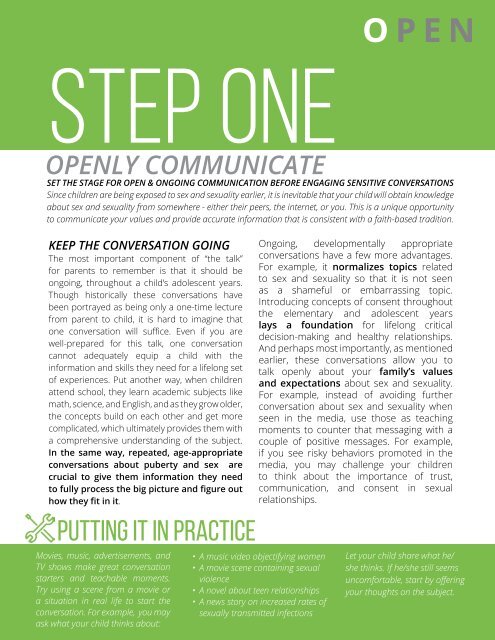Let’s Talk ABOUT SEX
parentsextalk
parentsextalk
Create successful ePaper yourself
Turn your PDF publications into a flip-book with our unique Google optimized e-Paper software.
STEP ONE<br />
OPENLY COMMUNICATE<br />
KEEP THE CONVERSATION GOING<br />
The most important component of “the talk”<br />
for parents to remember is that it should be<br />
ongoing, throughout a child’s adolescent years.<br />
Though historically these conversations have<br />
been portrayed as being only a one-time lecture<br />
from parent to child, it is hard to imagine that<br />
one conversation will suffice. Even if you are<br />
well-prepared for this talk, one conversation<br />
cannot adequately equip a child with the<br />
information and skills they need for a lifelong set<br />
of experiences. Put another way, when children<br />
attend school, they learn academic subjects like<br />
math, science, and English, and as they grow older,<br />
the concepts build on each other and get more<br />
complicated, which ultimately provides them with<br />
a comprehensive understanding of the subject.<br />
In the same way, repeated, age-appropriate<br />
conversations about puberty and sex are<br />
crucial to give them information they need<br />
to fully process the big picture and figure out<br />
how they fit in it.<br />
O PEN<br />
SET THE STAGE FOR OPEN & ONGOING COMMUNICATION BEFORE ENGAGING SENSITIVE CONVERSATIONS<br />
Since children are being exposed to sex and sexuality earlier, it is inevitable that your child will obtain knowledge<br />
about sex and sexuality from somewhere - either their peers, the internet, or you. This is a unique opportunity<br />
to communicate your values and provide accurate information that is consistent with a faith-based tradition.<br />
PUTTING IT IN PRACTICE<br />
Movies, music, advertisements, and<br />
TV shows make great conversation<br />
starters and teachable moments.<br />
Try using a scene from a movie or<br />
a situation in real life to start the<br />
conversation. For example, you may<br />
ask what your child thinks about:<br />
Ongoing, developmentally appropriate<br />
conversations have a few more advantages.<br />
For example, it normalizes topics related<br />
to sex and sexuality so that it is not seen<br />
as a shameful or embarrassing topic.<br />
Introducing concepts of consent throughout<br />
the elementary and adolescent years<br />
lays a foundation for lifelong critical<br />
decision-making and healthy relationships.<br />
And perhaps most importantly, as mentioned<br />
earlier, these conversations allow you to<br />
talk openly about your family’s values<br />
and expectations about sex and sexuality.<br />
For example, instead of avoiding further<br />
conversation about sex and sexuality when<br />
seen in the media, use those as teaching<br />
moments to counter that messaging with a<br />
couple of positive messages. For example,<br />
if you see risky behaviors promoted in the<br />
media, you may challenge your children<br />
to think about the importance of trust,<br />
communication, and consent in sexual<br />
relationships.<br />
• A music video objectifying women<br />
• A movie scene containing sexual<br />
violence<br />
• A novel about teen relationships<br />
• A news story on increased rates of<br />
sexually transmitted infections<br />
Let your child share what he/<br />
she thinks. If he/she still seems<br />
uncomfortable, start by offering<br />
your thoughts on the subject.


